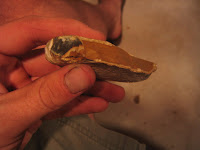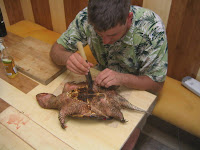***WARNING: Graphic photos of a dead deer***
I learned several things today while on a run/walk in the woods. Some of it happened on the walk, but most of it came from putting together pieces of events that happened throughout the day.
First I went to my Jiu-Jitsu school's belt promotion ceremony (www.grappling.com) and watched people who had been practicing this art for years be recognized for their hard work and dedication. The underlying message, however, was that the goal is to be a good person and improve the world, not earn some external prize. When watching this ceremony I reflected on my own journey with various arts so far, and how in the beginning, whether it was a job,
fire-making, flintknapping, or Jiu-Jitsu, I thought of building skills as a sprint- to see how far I could go how fast. As life has it, sprinting eventually makes you tired, and in your haste you stumble, maybe fall. In time I came to see skills as more of a marathon, and endurance race. Today, however, I simply saw them as a lifestyle. You don't
truly get better at things by striving to achieve specific end points you get better by making skills practice a part of who you are.
Later in the day as I was running down a steep trail in
Rock Creek Park, I caught a whiff of
Red Fox scent in the air and had a feeling that I should turn to my right. There, at the bottom of a ravine, behind a fence, was a fallen
Whitetail. Upon closer inspection I noticed that the deer was a young buck in velvet, antlers 8-10" long, probably 1.5 years old. He had obviously been th

ere for at least a day because of the flies around his muzzle and evidence of carnivores at the rump. (The photos were taken the next day, after the carcass was opened by Turkey Vultures). I could see that deer jumped the fence here because a section of the barbed wire was down, there were tracks, and a hillside they could use to gain an advantage on the 8+ foot fence. At first I thought he may have impaled himself trying to jump the fence, but when I looked at his head I could see that the bottom corner of the fence was peeled up and his head poked through to my side. His shoulder was bruised and bloody, and the earth around his back legs was disturbed, showing signs of a struggle. Then I saw his antlers- defiantly pressed against the fence, blocking his retreat, and a new theory emerged.
It seems as if this deer tried to go under the fence, a move that he may have done all last year when he was just a bit smaller, but found his shoulders too broad to get through. When he tried to back out, however, his newly grown antlers acted like the barbs of a fish hook,

catching on the reverse where the had passed easily on entry. As I pondered this deer's life and death I though back to Jiu-Jitsu, both seemed to echo off each other in my mind. I can't say for sure what it means, but it feels like something about how
we see our own growth. Do we acknowledge it? Do we work with it? Do we honor it? Either way, one truth is inescapable:
we're not who we were last year.
This interpretation brings me back to a conversation I had between Jiu-Jitsu and the run with a co-worker at the job I recently quit and will be leaving in a week. He's just arrived and I'm on my way out, so we had a unique opportunity to compare perspectives on this company, and through our conversation I discovered why I'm actually leaving. Although it's been messy, conflicted and sudden seeming, the reason I'm leaving, like many other good people that have worked for this company, is that it offered me no opportunity to grow. We analyzed the pattern of people coming and going, and that one fact stuck out, and it's human nature. We need to grow,
we are growing. As we naturally outgrow people, situations and environments, we either must change them or begin to limit ourselves. The more we restrict ourselves unnaturally, the more imbalanced we will become. It's fascinating how we understand this with fishbowls

and plants...but often not ourselves.
(This last photo is a worked biface of beautiful striped quartzite I found a few feet from the deer when I went back the next day.)





































